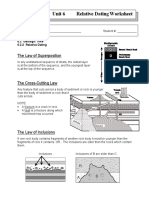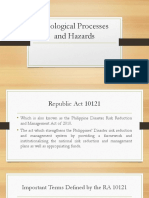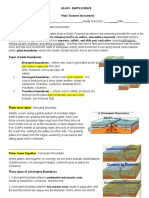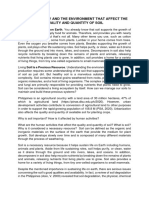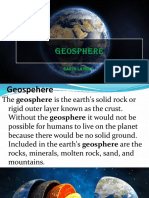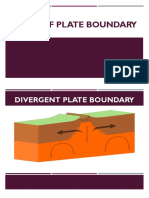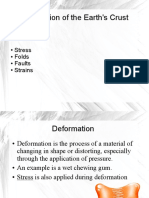0 ratings0% found this document useful (0 votes)
123 viewsWhy Earth's Interior Is Hot
Why Earth's Interior Is Hot
Uploaded by
Rem LayogThe high temperatures inside Earth are a result of heat left over from the formation of the planet. This rapid rise of temperature continues for several tens of km, and continues to grow hotter and hotter approaching the core. The Earth's interior is composed of layers including the crust, mantle, and core. The inner core is solid iron and nickel reaching 5000 degrees C due to extreme pressure, and it produces the Earth's magnetic field.
Copyright:
© All Rights Reserved
Available Formats
Download as PPT, PDF, TXT or read online from Scribd
Why Earth's Interior Is Hot
Why Earth's Interior Is Hot
Uploaded by
Rem Layog0 ratings0% found this document useful (0 votes)
123 views12 pagesThe high temperatures inside Earth are a result of heat left over from the formation of the planet. This rapid rise of temperature continues for several tens of km, and continues to grow hotter and hotter approaching the core. The Earth's interior is composed of layers including the crust, mantle, and core. The inner core is solid iron and nickel reaching 5000 degrees C due to extreme pressure, and it produces the Earth's magnetic field.
Original Title
esppt
Copyright
© © All Rights Reserved
Available Formats
PPT, PDF, TXT or read online from Scribd
Share this document
Did you find this document useful?
Is this content inappropriate?
The high temperatures inside Earth are a result of heat left over from the formation of the planet. This rapid rise of temperature continues for several tens of km, and continues to grow hotter and hotter approaching the core. The Earth's interior is composed of layers including the crust, mantle, and core. The inner core is solid iron and nickel reaching 5000 degrees C due to extreme pressure, and it produces the Earth's magnetic field.
Copyright:
© All Rights Reserved
Available Formats
Download as PPT, PDF, TXT or read online from Scribd
Download as ppt, pdf, or txt
0 ratings0% found this document useful (0 votes)
123 views12 pagesWhy Earth's Interior Is Hot
Why Earth's Interior Is Hot
Uploaded by
Rem LayogThe high temperatures inside Earth are a result of heat left over from the formation of the planet. This rapid rise of temperature continues for several tens of km, and continues to grow hotter and hotter approaching the core. The Earth's interior is composed of layers including the crust, mantle, and core. The inner core is solid iron and nickel reaching 5000 degrees C due to extreme pressure, and it produces the Earth's magnetic field.
Copyright:
© All Rights Reserved
Available Formats
Download as PPT, PDF, TXT or read online from Scribd
Download as ppt, pdf, or txt
You are on page 1of 12
Why Earth’s Interior Is Hot
This rapid rise of temperature
continues for several tens of km, and
continues to grow hotter and hotter
approaching the core. The high
temperatures inside Earth are a result
of heat left over from the formation
of the planet.
Earth’s Interior
The three main layers
of Earth are the crust,
the mantle, and the
core. These layers
vary greatly in size,
composition,
temperature, and
pressure
The Earth’s Core
Much of the information scientists
have about the Earth’s interior has
come not only from complex
instruments but also from
earthquakes.
Both layers of the Earth’s core are
made of the elements iron and
nickel.
The Inner Core
The solid inner layer is called the inner
core. The temperature reaches 5000
degrees C, the temperature at which
iron and nickel usually melt. The
extreme pressure pushes the particles
so tightly together that they remain
solid. The solid iron produces a
magnetic field.
The Outer Core
Surrounding the inner core is the
second layer of the Earth, called the
outer core. The outer core begins
about 2900 km below the Earth’s
surface and is 2250 km thick. The
temperatures range from 2200 to 5000
degrees C. The heat makes the iron
and nickel molten.
The Earth’s Mantle
The layer of the Earth directly
above the outer layer is the mantle.
The mantle extends to a depth of
about 2900 km below the surface.
About 88% of the volume of the
Earth and 68% of the mass are in
the mantle.
Composition of the Mantle
After studying rocks from volcanoes and
the ocean floor, scientists think the
mantle is made of the elements silicon,
oxygen, iron and magnesium. The
density of the mantel increases with
depth. The high temperature and
pressure in the mantle allow the solid
rock to flow slowly, thus changing
shape. This is the property of plasticity.
The Earth’s Crust
The Earth’s crust is its thin
outermost layer. The crust is
much thinner than the mantle and
the outer and inner cores. All life
on Earth exists on or within a few
hundred meters above the crust.
Composition of the Crust
The crust is made of three
types of solid rocks: igneous,
sedimentary and
metamorphic rocks. The
thickness of the Earth’s crust
varies.
Temperature
About 20 meters below Earth’s
surface, rock begins to get warmer.
For every 40 meters that you descend
from that point, the temperature rises 1
degree Celsius. This rapid rise of
temperature continues for several tens
of km, and continues to grow hotter
and hotter approaching the core. The
high temperatures inside Earth are a
result of heat left over from the
formation of the planet.
Pressure
The more you descend into Earth’s interior, the amount of
pressure increases. Pressure results from a force pressing
on an area. Because of the weight of the rock above,
pressure inside Earth increases as you go deeper. The
deeper you go, the greater the pressure.
THANK YOU!!!
You might also like
- Relative Dating Worksheet Whats Up KeyDocument4 pagesRelative Dating Worksheet Whats Up Keyivyfairies100% (2)
- Grolier BooksDocument4 pagesGrolier BooksOmar CirunayNo ratings yet
- A Model of Three Faults ActivityDocument5 pagesA Model of Three Faults ActivityEileen Joy Noceda50% (2)
- Product Sheet DynoPerform enDocument3 pagesProduct Sheet DynoPerform enandrebmichelNo ratings yet
- Geological Processes and HazardsDocument47 pagesGeological Processes and HazardsJin Kazama100% (2)
- Plate Tectonic Movements WSDocument4 pagesPlate Tectonic Movements WSLyle ThimotheoNo ratings yet
- Refrigerator: Service ManualDocument109 pagesRefrigerator: Service ManualJuan Carlos Galeano NavarroNo ratings yet
- SCIENCE 11 WEEK 6c - Endogenic ProcessDocument57 pagesSCIENCE 11 WEEK 6c - Endogenic ProcessChristine CayosaNo ratings yet
- Characteristics of The EarthDocument44 pagesCharacteristics of The EarthZay SalazarNo ratings yet
- (6.1) Major Events in Earth's PastDocument21 pages(6.1) Major Events in Earth's PastSheena SesucaNo ratings yet
- Melc 9 Stratification of RocksDocument26 pagesMelc 9 Stratification of Rockslost at sea100% (1)
- Department of Education: Republic of The PhilippinesDocument6 pagesDepartment of Education: Republic of The PhilippinesJanna GunioNo ratings yet
- Activities That Affect The Quality and Quantity of SoilDocument7 pagesActivities That Affect The Quality and Quantity of SoilEli ..No ratings yet
- Tectonic Word PowerDocument3 pagesTectonic Word PowerJonathan0% (2)
- Impulse and MomentumDocument31 pagesImpulse and MomentumFrancisQuiwaNo ratings yet
- Lesson 1.3 - Nebular TheoryDocument2 pagesLesson 1.3 - Nebular TheoryMaria Adeza PereñaNo ratings yet
- Stratification - LectureDocument16 pagesStratification - LectureMARIA LOURDES MENDOZANo ratings yet
- Science 10Document25 pagesScience 10Renato Jr Bernadas Nasilo-anNo ratings yet
- Earth Science: Quarter 2 - Week 5: Formation of Stratified Rocks Relative and Absolute DatingDocument19 pagesEarth Science: Quarter 2 - Week 5: Formation of Stratified Rocks Relative and Absolute DatingRaj DasNo ratings yet
- The Rock CycleDocument31 pagesThe Rock CycleRoan Eam TanNo ratings yet
- Earth and Life Science SHS 17.2 Sexual Reproduction in PlantsDocument29 pagesEarth and Life Science SHS 17.2 Sexual Reproduction in PlantsWinsear VardeNo ratings yet
- History of The EarthDocument40 pagesHistory of The EarthMarJen50% (2)
- Earth Science-Q1-Week-5 - v.2Document19 pagesEarth Science-Q1-Week-5 - v.2Edlyn PolendeyNo ratings yet
- Summative Test No. 1 - Module 1 Q3Document5 pagesSummative Test No. 1 - Module 1 Q3Bing Sepe CulajaoNo ratings yet
- Earth SubsystemsDocument35 pagesEarth Subsystemsjoel lacayNo ratings yet
- 2nd Summative Test Earth and LifeDocument3 pages2nd Summative Test Earth and LifeJarven SaguinNo ratings yet
- Earth Science For STEM: Quarter 2 - Module 6: Seafloor SpreadingDocument7 pagesEarth Science For STEM: Quarter 2 - Module 6: Seafloor SpreadingCheena Francesca LucianoNo ratings yet
- Seafloor Spreading ActivityDocument3 pagesSeafloor Spreading ActivityFrancheska McHaleNo ratings yet
- Earth Science SHS Unit 9 Human Activity and The Environment Study GuideDocument59 pagesEarth Science SHS Unit 9 Human Activity and The Environment Study GuideSpicychicken NuggetssNo ratings yet
- Earth Science NotesDocument40 pagesEarth Science NotesGeneen LouiseNo ratings yet
- Projectile MotionDocument17 pagesProjectile MotionErickson Acomular100% (1)
- Earth - Life 11 - Q1 - M9Document15 pagesEarth - Life 11 - Q1 - M9Patrick Bolinbough100% (1)
- Characteristics of Earth That Makes It HabitableDocument17 pagesCharacteristics of Earth That Makes It HabitableBernard GonzalesNo ratings yet
- LAS Earth Science 9Document9 pagesLAS Earth Science 9Precious NicoleNo ratings yet
- 3 Types of Rocks PPTDocument35 pages3 Types of Rocks PPTMyla Balingit Adi100% (1)
- Stratified RocksDocument16 pagesStratified RocksJanuxie ParkNo ratings yet
- GEOSPHEREDocument18 pagesGEOSPHEREPennie KoscaNo ratings yet
- Introduction To Science Investigatory Project (S.I.P) : Lester Gene V. ArevaloDocument19 pagesIntroduction To Science Investigatory Project (S.I.P) : Lester Gene V. ArevaloLester Gene Villegas ArevaloNo ratings yet
- Intermediate IVMO Sample 1Document11 pagesIntermediate IVMO Sample 1jericoNo ratings yet
- Earth and Life Science SHS 8.2 Magmatism - How Magma Is FormedDocument15 pagesEarth and Life Science SHS 8.2 Magmatism - How Magma Is FormedTrishanne PilapilNo ratings yet
- Earth Science Reviewer Rocks and MineralsDocument3 pagesEarth Science Reviewer Rocks and MineralsCherry VillamorNo ratings yet
- Endogenic ProcessesDocument36 pagesEndogenic Processesantonio AlmiranesNo ratings yet
- T18 Magma and Volcanism PART 2Document21 pagesT18 Magma and Volcanism PART 2Sako100% (1)
- STEM11 - Earth Science NotesDocument28 pagesSTEM11 - Earth Science NotesPatricia Gabriell MulaNo ratings yet
- Science Activity Sheet Quarter 2-4 Week 4: Carbon CompoundsDocument6 pagesScience Activity Sheet Quarter 2-4 Week 4: Carbon CompoundsRodney Barba100% (1)
- Activity 2 Our Dynamic EarthDocument4 pagesActivity 2 Our Dynamic EarthDM Angcaya100% (1)
- Types of Plate BoundaryDocument16 pagesTypes of Plate BoundaryGianyla BalayoNo ratings yet
- Earth and Its Subsystems by Sura J. AmilbaharDocument35 pagesEarth and Its Subsystems by Sura J. AmilbaharAmilbahar Sura100% (2)
- Classification of RocksDocument43 pagesClassification of RocksJoshNo ratings yet
- NLC Math 1 Intervention WB v.1Document88 pagesNLC Math 1 Intervention WB v.1Sofia BolivarNo ratings yet
- Ground ShakingDocument20 pagesGround ShakingCeejay Caneba100% (1)
- Advancement On The Solar SystemDocument2 pagesAdvancement On The Solar SystemLaijanie Claire Gonzales Alvarez100% (1)
- Coastal Processes and HazardDocument25 pagesCoastal Processes and HazardJonard Flores100% (1)
- Three Types of UnconformitiesDocument5 pagesThree Types of Unconformitiesvenkatakrishna chalapaathiNo ratings yet
- Deformation of The CrustDocument16 pagesDeformation of The CrustLoneSoul100% (1)
- Marine and Coastal ProcessDocument32 pagesMarine and Coastal ProcessCamila Rangas CuartoNo ratings yet
- HANDOUT MetamorphismDocument4 pagesHANDOUT MetamorphismHow Ever100% (1)
- Earth Science (Earth and Rocks)Document10 pagesEarth Science (Earth and Rocks)Janna Myca MarananNo ratings yet
- Earthquakes VolcanoesDocument5 pagesEarthquakes VolcanoesHusna Hafiza RazamiNo ratings yet
- Geomorphic ProcessDocument17 pagesGeomorphic ProcessFikri AzyNo ratings yet
- Characteristics of Planet EarthDocument17 pagesCharacteristics of Planet EarthAna SelviaNo ratings yet
- Earths Interior HeatDocument30 pagesEarths Interior HeatK-Ann AcostaNo ratings yet
- Organic Chemistry Laboratory: Report 6: Reflux ReactionDocument7 pagesOrganic Chemistry Laboratory: Report 6: Reflux ReactionPhú NguyễnNo ratings yet
- EthologyDocument7 pagesEthologyOnnNo ratings yet
- Biogas IntroductionDocument75 pagesBiogas IntroductionRohan JindalNo ratings yet
- An Overview of CO2 Capture TechnologiesDocument25 pagesAn Overview of CO2 Capture Technologiesherschel5100% (1)
- SM Group Assignment StarbucksDocument11 pagesSM Group Assignment Starbucksrupal patidarNo ratings yet
- Poqui PoquiDocument2 pagesPoqui PoquiYvet KatNo ratings yet
- SIG Sauer - Spear - ManualDocument108 pagesSIG Sauer - Spear - Manuallarxv18No ratings yet
- Daniel ADocument2 pagesDaniel AMuanchhana MizoNo ratings yet
- CR 10260-1998-OtklDocument21 pagesCR 10260-1998-OtklVasko MandilNo ratings yet
- Downloadfile 17Document9 pagesDownloadfile 17Golam ZakariaNo ratings yet
- VersaLink B405 Service ManualDocument858 pagesVersaLink B405 Service ManualAlex Rodriguez Barron100% (1)
- Sulaiman NajiDocument2 pagesSulaiman Najiapi-358997781No ratings yet
- Curved Surface Boosts Electrochemical CO2 Reduction To Formate Via Bismuth Nanotubes in A Wide Potential WindowDocument7 pagesCurved Surface Boosts Electrochemical CO2 Reduction To Formate Via Bismuth Nanotubes in A Wide Potential WindowSantosh Srinivas NNo ratings yet
- Assignment 01: Shaikh Ayaz University ShikarpurDocument7 pagesAssignment 01: Shaikh Ayaz University ShikarpurAakib Arijit ShaikhNo ratings yet
- ExxonMobil VPQ Review FormDocument30 pagesExxonMobil VPQ Review FormTruong's100% (3)
- Character Analysis: An Angel in Disguise. Thematic Analysis: The Cold WithinDocument5 pagesCharacter Analysis: An Angel in Disguise. Thematic Analysis: The Cold WithinHarshaditya KohliNo ratings yet
- C45 Medium Carbon Steel - Hillfoot Multi MetalsDocument1 pageC45 Medium Carbon Steel - Hillfoot Multi MetalsEnter ExitNo ratings yet
- الاقناع اسسه واهدافه في ضوء اسلوب القران الكريم PDFDocument42 pagesالاقناع اسسه واهدافه في ضوء اسلوب القران الكريم PDFمقداد هادي ال فياضNo ratings yet
- Dyeing of Polyester 777777777Document14 pagesDyeing of Polyester 777777777dhuraibhaarathiNo ratings yet
- Prevalence of Anaemia Among Adolescent Girls: A Cross Sectional Exploratory StudyDocument3 pagesPrevalence of Anaemia Among Adolescent Girls: A Cross Sectional Exploratory StudyJamilaNo ratings yet
- DAV - Geography - Natural Resources Land Soil WaterDocument12 pagesDAV - Geography - Natural Resources Land Soil WaterSMKNo ratings yet
- Initial Environmental Examination (ADB) Environmental and Social Management Plan (ESMP)Document56 pagesInitial Environmental Examination (ADB) Environmental and Social Management Plan (ESMP)dusanNo ratings yet
- (WM) Pajero (V8#,V9#)Document1 page(WM) Pajero (V8#,V9#)antothoppil001No ratings yet
- Allergic Rhinitis Is Associated With Loss of Energy and Concentration Difficulty: A Cross-Sectional StudyDocument7 pagesAllergic Rhinitis Is Associated With Loss of Energy and Concentration Difficulty: A Cross-Sectional StudyandiniNo ratings yet
- TECHNOLOGY OF SOLID DOSAGE FORMS Unit 1Document16 pagesTECHNOLOGY OF SOLID DOSAGE FORMS Unit 1Little SparkNo ratings yet
- Impaired Physical MobilityDocument3 pagesImpaired Physical MobilityCharmaine ChuaNo ratings yet
- Bone AssignmentDocument21 pagesBone AssignmentTayaba Naim KhanNo ratings yet
- Tayag v. CA (Jacalne)Document2 pagesTayag v. CA (Jacalne)Jericho JacalneNo ratings yet
